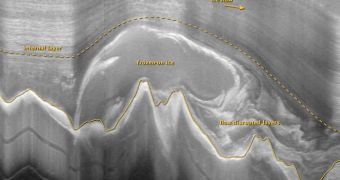For decades, climate scientists have believed that ice sheets and caps only grow as snow that accumulates on top gets pressed by other layers of snow, and turned into ice. But this view is now being disproved by a new study, which finds that ice can also form at the bottom of sheets and caps.
This was discovered by experts working in Antarctica. A team of scientists found important levels of ice formation underneath the massive ice sheets that extend about 2 to 3 kilometers above the land.
Unlike the Arctic, which is in essence a free-floating ice shelf, the Antarctic is made up of a thick layer of ice that rests on a firm foundation. Tens of millions of years ago, the area was in fact a lush refuge for a wide variety of animal species.
With the new conclusions, scientists may finally gain the ability to augment the accuracy of computer models they use predict how glaciers move around. Ice is known to be capable of traveling in all directions except uphill.
If new ice is formed at the base of glaciers, then its patterns of horizontal motion are extended, say experts, when compared to how the structures would be capable of moving if they only grew from the top down, NASA Earth Observatory reports.
The data used for this research were collected between November 2008 and January 2009, by an international collaboration of researchers that operated a Twin Otter aircraft. They flew multiple sorties over East Antarctica, and specifically over the Gamburtsev Mountains.
In order to investigate what goes on underneath the ices, the airplane was equipped with gravity meters, magnetometers, laser ranging systems and ice-penetrating radars. The work was conducted under the International Polar Year, and was partially funded by the US National Science Foundation (NSF).
“We usually think of ice sheets like cakes – one layer at a time, added from the top. This is like someone injected a layer of frosting at the bottom – a really thick layer,” explains Columbia University Lamont-Doherty Earth Observatory geophysicist Robin Bell.
“Water has always been known to be important to ice sheet dynamics, but mostly as a lubricant. As ice sheets change, we want to predict how they will change. Our results show that models must include water beneath,” the investigator adds.
According to experts, the reason why ice formation takes place under the ice sheet is because lakes of liquid water already exist there. However, that water usually cannot freeze, primarily because the ice above it acts as an insulator, but also due to the extreme pressure the ices exert on it.
Under some specific conditions, those lakes can refreeze instantly, and experts believe that this is why they are seeing this process go on in their scans.

 14 DAY TRIAL //
14 DAY TRIAL //